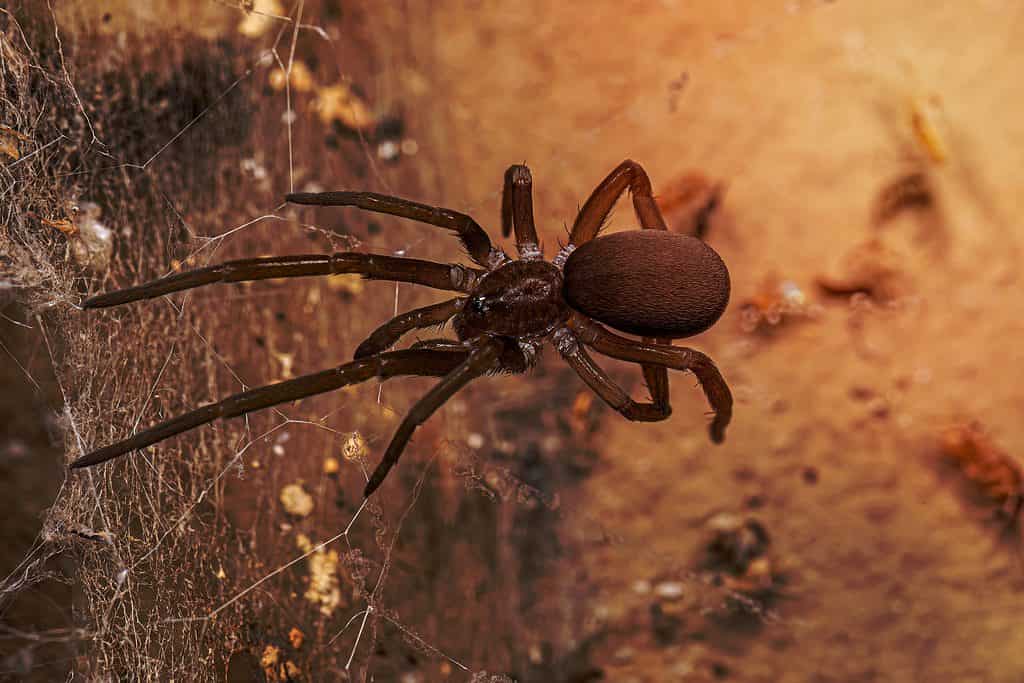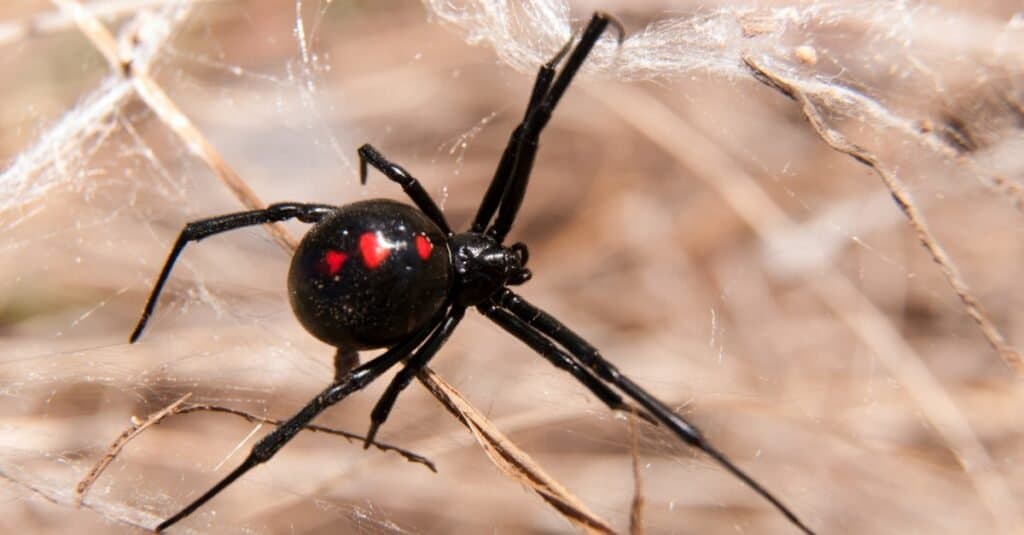Spiders inhabit most areas of the world, but some regions provide a better environment than others. North Carolina has a mild, relatively humid climate and varied terrain, perfect for all kinds of creepy crawly bugs and arachnids. Almost 60% of the state is covered in forests. And even residential areas are often nestled around plenty of greenery, which makes excellent homes for spiders of all colors, shapes, and sizes. Discover five black spiders in North Carolina and learn about their appearance, habitat, and threat risk.
Southern House Spider

You won’t see southern house spiders much during the day as they like to hide in dark corners. But at night, they come out on their webs.
©postolocanu/Shutterstock.com
The southern house spider is common in the Southern United States and inhabits areas near humans. This species features sexual dimorphism, where the female is charcoal gray to black, and the male is tan to amber. These spiders prefer the dark spaces in homes and buildings, where they weave a woolly web in sheltered crevices away from people.
Only females build webs, while males spend their lives searching for a mating partner. You won’t see them much during the day as they like to hide in dark corners. But at night, they come out and perch on their webs. And they can be either inside or outside of manmade structures. The southern house spider is harmless to humans. They do not bite frequently. And if they do, it is not medically significant.
False Black Widow

While they look deadly, false widows are not harmful to humans. At most, their bites may cause some localized pain.
©Dan Olsen/Shutterstock.com
Though similar in appearance, the false black widow differs from the true black widow. The female false widow has a more oval abdomen and lacks the red hourglass marking. These spiders can vary in color from black to dark brown and reddish-brown. They also make an irregular-shaped web and are known for eating other spiders, including the true black widow.
You will find this species up and down the East Coast, where it is common in homes in the southern states. While they look deadly, false widows are not harmful to humans. At most, their bites may cause some localized pain.
Black Widow

Black widow spider
bites rarely kill people, but it’s important to get medical attention as soon as you can because they can make you very sick.
©Sari ONeal/Shutterstock.com
The notorious black widow spider is about the size of a paperclip, with long legs, a large, round abdomen, and a distinctive red hourglass marking. The black widow and the brown recluse are the only two medically significant spiders in North Carolina.
The black widow’s venom is 15 times stronger than a rattlesnake’s. However, these spiders are not considered aggressive. They typically avoid people and only bite when someone accidentally sits on them or in other similar situations. Their bites can cause muscle aches, nausea, and trouble breathing. But serious damage and death are very rare in most cases. They like dark, dry places. And while they typically live outside under piles of wood, they often find their way inside and inhabit dark crevices.
Black Lace Weaver

The black lace weaver is a native of Europe, found in Ireland, but also across North America and New Zealand.
©Wildsmith_Westwood/Shutterstock.com
The black lace weaver is a nocturnal spider that likes to live near manmade structures. They are dark in color, ranging from black, brown, dark red, and khaki. They have large, round abdomens and pale markings. And they like to hide in dark areas, especially under logs, stones, or inside moist cellars. You can find them inside or outside, especially in the spring, as males walk around searching for mates.
This species is originally from Europe but has found its way to the United States and now inhabits many areas in North Carolina. While the black lace weaver may bite if threatened, their venom is not potent enough to send humans to the emergency room. At most, you might encounter localized swelling and pain.
Daring Jumping Spider

The daring jumping spider possesses excellent eyesight and leaping abilities which it relies on to catch its prey
©Mircea Costina/Shutterstock.com
Daring jumping spiders, or bold jumping spiders, are a very common species found throughout the United States and Southeastern Canada. They are typically all black with oval-shaped abdomens and distinctive white triangle markings on their backs.
You are more likely to find this spider in your backyard, open woodlands, gardens, prairies, and old fields. While they produce venom like all spiders, their bites are not significant to humans. Plus, they are more likely to run (or jump) away from humans than to stay and bite.
The photo featured at the top of this post is © Jay Ondreicka/Shutterstock.com
Thank you for reading! Have some feedback for us? Contact the AZ Animals editorial team.






